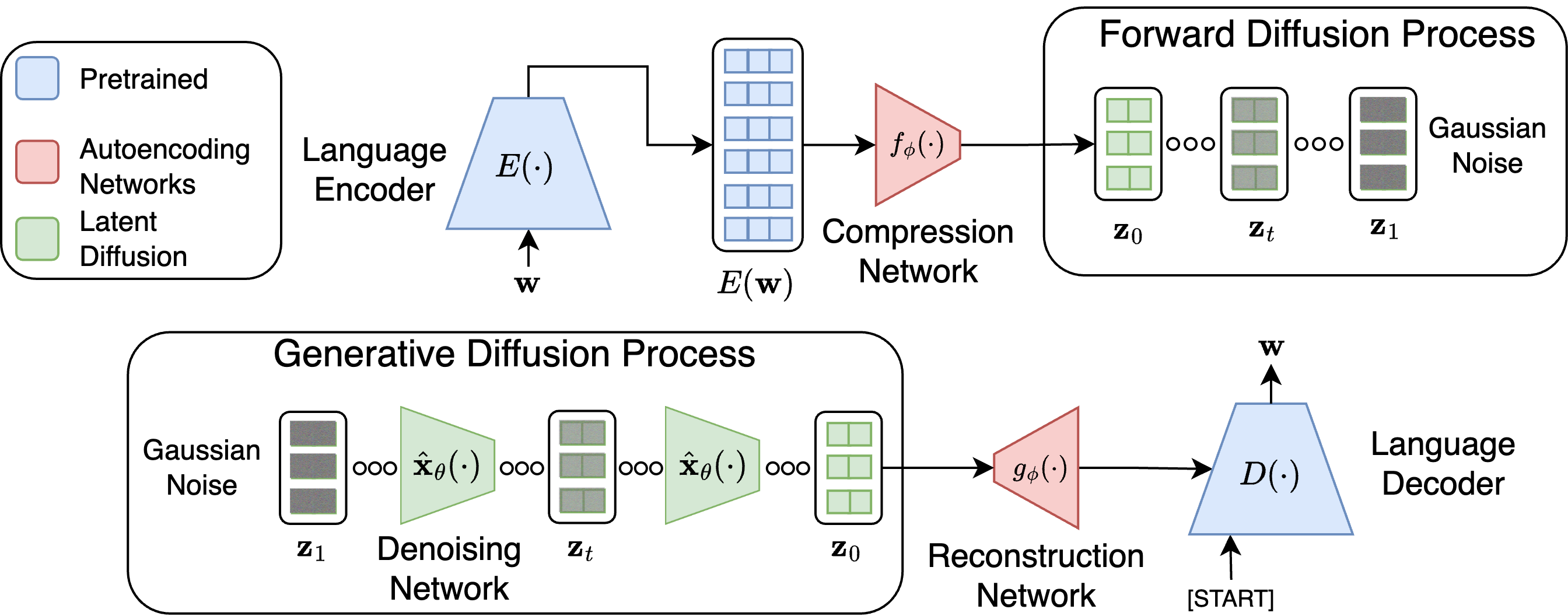Latent Diffusion for Language Generation
Introduction
The paper "Latent Diffusion for Language Generation" (2212.09462) addresses a fundamental challenge in adapting diffusion models for discrete domains, such as language, by leveraging a latent space framework. Traditional diffusion models, highly successful in continuous domains like image, audio, and video generation, struggle with the discrete nature of language. The authors propose the Latent Diffusion for Language Generation (LD4LG) technique that harmoniously integrates encoder-decoder LLMs with continuous diffusion processes in a latent space attained via a language autoencoder.
Methodology
The LD4LG framework comprises two core components: the language autoencoder and the continuous diffusion model. Initially, a pre-trained encoder-decoder model, such as BART or T5, is used to generate high-dimensional text representations. These representations are then compressed into a low-dimensional latent space using a Perceiver Resampler architecture, forming the basis of a high-quality language autoencoder.
Language Autoencoder
The encoder component generates latent representations of the input text which are then compressed using a Perceiver Resampler. This transformation optimizes the representations for diffusion by mapping them into a fixed-length, continuous latent space suitable for modeling by the diffusion process. The autoencoder is trained to reconstruct the original input text via a decoder, ensuring fidelity to natural language generation.
Latent Diffusion Model
The diffusion model operates on the low-dimensional latents generated by the autoencoder. A denoising network, designed with a transformer architecture, iteratively transforms Gaussian noise into coherent latent representations of text. Self-conditioning, a technique that involves conditioning on previous predictions, is employed to enhance model stability and performance.

Figure 1: Overview of our proposed latent language diffusion framework.
Implementation Considerations
The paper outlines comprehensive implementation strategies with the LD4LG model trained using NVIDIA A6000 GPUs. Key hyperparameters such as learning rates, batch sizes, and gradient clipping are finely tuned to ensure robust model performance.
- Sampling Steps: Optimal results are obtained with 250 diffusion steps, balancing trade-offs between text quality and computational efficiency.
- Normalization: Norm constraints ensure that latents are suitably scaled for diffusion, while resampling techniques refine latent representations, safeguarding model efficacy across diverse text datasets.
- Model Architecture: Transformers with adaptively conditioned layer normalization effectively parameterize the denoising network, achieving superior generative outcomes.
- Noise Schedules: A cosine noise schedule is employed by default, although adaptations such as scaled cosine noise schedules are applied to enhance machine translation tasks.
The novel LD4LG models demonstrate significant advancements over prior diffusion-based LLMs across several benchmarks. For instance, on the ROCStories dataset, the MAUVE score for LD4LG with BART-base reached .716 compared to Diffusion-LM with .043, underscoring the efficiency of latent diffusion models. Importantly, LD4LG models excel with consistently fewer sampling steps than their predecessors, indicating computational superiority.
Through comparisons across datasets like XSum and QQP, LD4LG not only shows notable performance improvements but also highlights its robustness across sequence-to-sequence tasks. This adaptability showcases potential scalability in handling diverse language generation tasks from summarization to paraphrasing.
Discussion and Future Work
The paper contributes a substantial enhancement to generative modeling in discrete domains by applying latent diffusion principles to language tasks. A key takeaway is the success of compressing high-dimensional encoder representations into diffusion-suitable latents, facilitating efficient and high-quality language generation.
The paper paves the way for future explorations into various diffusion applications, such as language editing and controllable generation.


